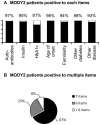Identification of candidate children for maturity-onset diabetes of the young type 2 (MODY2) gene testing: a seven-item clinical flowchart (7-iF)
- PMID: 24244580
- PMCID: PMC3823596
- DOI: 10.1371/journal.pone.0079933
Identification of candidate children for maturity-onset diabetes of the young type 2 (MODY2) gene testing: a seven-item clinical flowchart (7-iF)
Abstract
MODY2 is the most prevalent monogenic form of diabetes in Italy with an estimated prevalence of about 0.5-1.5%. MODY2 is potentially indistinguishable from other forms of diabetes, however, its identification impacts on patients' quality of life and healthcare resources. Unfortunately, DNA direct sequencing as diagnostic test is not readily accessible and expensive. In addition current guidelines, aiming to establish when the test should be performed, proved a poor detection rate. Aim of this study is to propose a reliable and easy-to-use tool to identify candidate patients for MODY2 genetic testing. We designed and validated a diagnostic flowchart in the attempt to improve the detection rate and to increase the number of properly requested tests. The flowchart, called 7-iF, consists of 7 binary "yes or no" questions and its unequivocal output is an indication for whether testing or not. We tested the 7-iF to estimate its clinical utility in comparison to the clinical suspicion alone. The 7-iF, in a prospective 2-year study (921 diabetic children) showed a precision of about the 76%. Using retrospective data, the 7-iF showed a precision in identifying MODY2 patients of about 80% compared to the 40% of the clinical suspicion. On the other hand, despite a relatively high number of missing MODY2 patients, the 7-iF would not suggest the test for 90% of the non-MODY2 patients, demonstrating that a wide application of this method might 1) help less experienced clinicians in suspecting MODY2 patients and 2) reducing the number of unnecessary tests. With the 7-iF, a clinician can feel confident of identifying a potential case of MODY2 and suggest the molecular test without fear of wasting time and money. A Qaly-type analysis estimated an increase in the patients' quality of life and savings for the health care system of about 9 million euros per year.
Conflict of interest statement
Figures


References
-
- Velho G (1992) Primary pancreatic beta-cell secretory defect caused by mutations in glucokinase gene in kindreds of maturity onset diabetes of the young. The Lancet 340: 444–448. - PubMed
-
- Schober E, Rami B, Grabert M, Thon a, Kapellen T, et al. (2009) Phenotypical aspects of maturity-onset diabetes of the young (MODY diabetes) in comparison with Type 2 diabetes mellitus (T2DM) in children and adolescents: experience from a large multicentre database. Diabetic medicine: a journal of the British Diabetic Association 26: 466–473. - PubMed
MeSH terms
Substances
Supplementary concepts
LinkOut - more resources
Full Text Sources
Other Literature Sources
Medical
Miscellaneous

